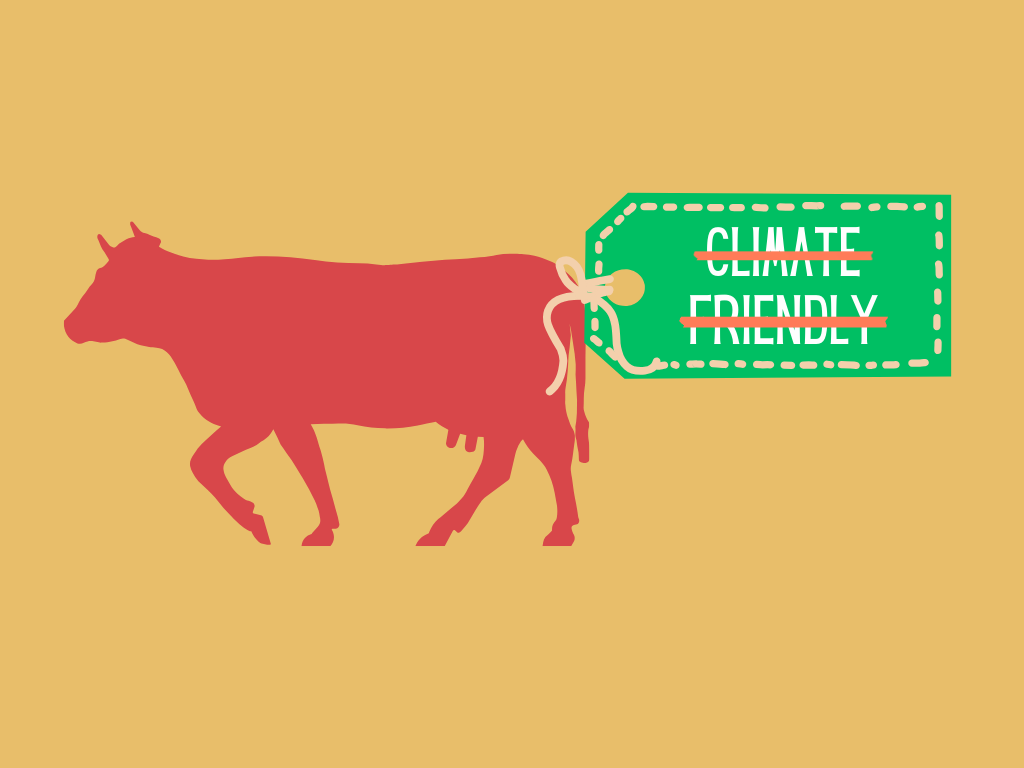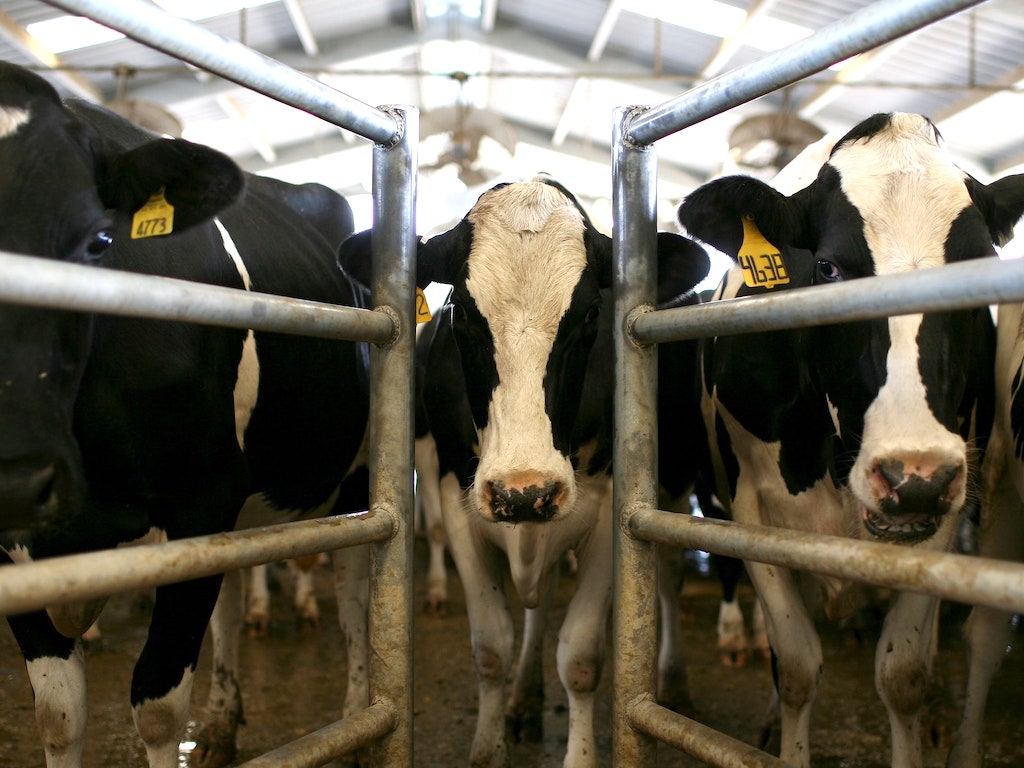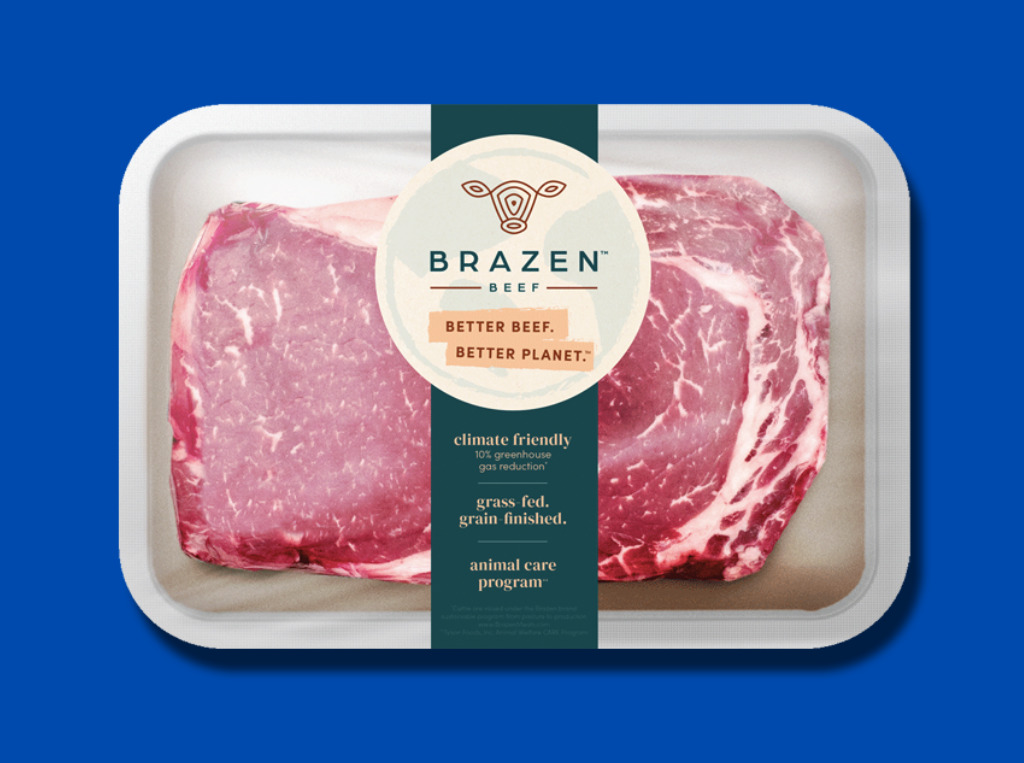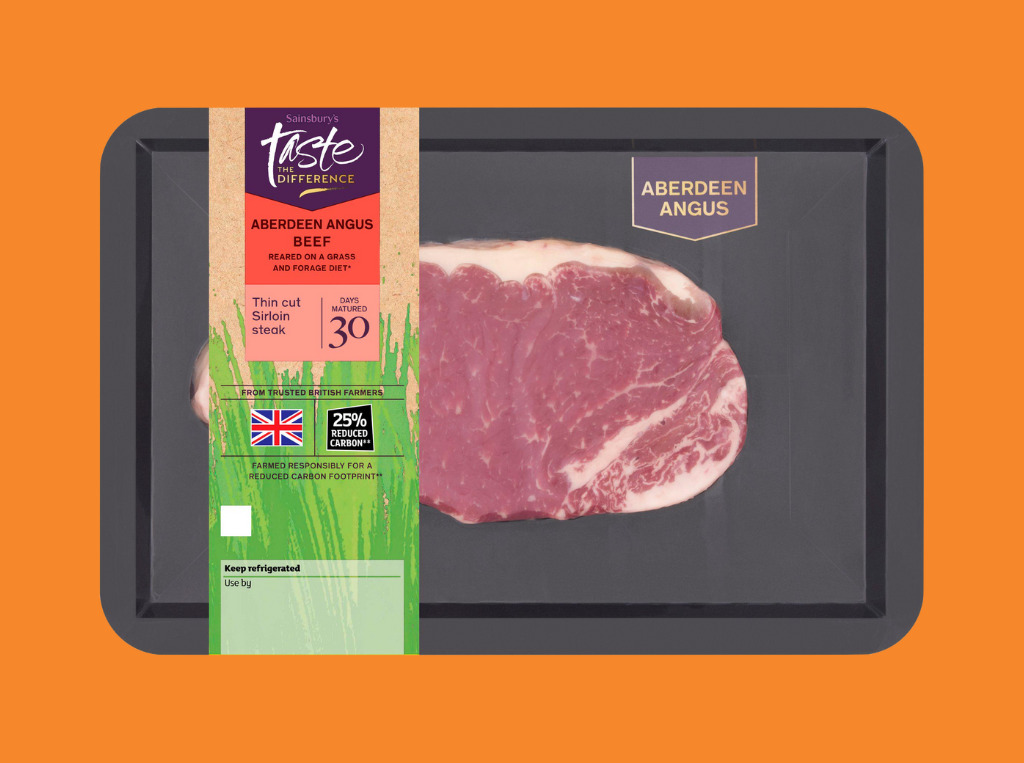7 Mins Read
UK retailer Sainsbury’s has launched a lower-carbon beef from its premium Taste the Difference line, a few weeks after US company Tyson Foods began retailing a USDA-approved “climate-friendly product as part of its Brazen Beef brand. But is low-carbon, climate-friendly beef even a thing – are we just kidding ourselves?
The company says the Taste the Difference Aberdeen Angus beef range will be available in just over 60 stores starting this week, with a nationwide expansion expected planned eventually, and includes a 12% and 5% fat mince, a 30-day rib eye steak and a 30-day beef roasting joint.
In a press release announcing the range on Monday, Sainsbury’s describes the new Angus beef as the “largest low-carbon beef range ever produced in the UK”, promising a 25% lower carbon footprint compared to the UK industry standard of 32.14kg CO2e per kg. The data comes from a life-cycle assessment commissioned by Sainsbury’s and conducted by independent body SAC Consulting, which describes itself as “providing independent, research-driven, industry-leading expertise, advice and solutions for agricultural, food, and land-based businesses” and which is part of charitable company Scotland’s Rural College (SRUC).
To achieve this reduction, the retailer says it combines its dairy and beef supply chains, breeds its dairy cows with its Aberdeen Angus genetics, and strictly monitors feed and living conditions. This, in turn, means that calves need less time and energy to grow – in other words, they have reduced the age of the herd used for beef, and are slaughtering them younger.
Feed management and the methane question

Sainsbury’s says superior cattle breeding and animal management has also led to a reduction in carbon emissions – but doesn’t provide specific details about either. When it comes to feed, it states in the press release that the cows are “suited to” a grass and forage diet. The latter includes plants like silage, grass and clover, “among many others”, though again, no specifics.
It’s key for the retailer to be more transparent about other forage plants – cows have been known to eat lethal amounts of water hemlock, or be poisoned by eating roots brought to the surface by ploughing or ditch-cleaning. Meanwhile, plants like bracken fern can interfere with nutrient retention due to thiamine-destroying substances. Other crops, including horsetail, buttercups and nightshade – ahem, among others – can also be poisonous to cows.
Sainsbury’s says its farmers feed in combination with grass and forage “to provide our cattle with the variety they require to exhibit natural grazing behaviours”. It’s unclear whether the cattle used for this lower carbon beef range is 100% pasture-fed, or partly grain-based as well. The terminology used by the company is ambiguous, meaning it’s very likely the latter – and using ‘grass-fed’ with no % to describe a cow’s diet that also includes grains is a common form of meat-industry greenwashing.
Even if the animals are fed a 100% pasture-based diet, research has shown that cows kept on pasture their whole lives can produce more methane than those on a grain diet in feedlots, owing to the additional fibre leading to higher methane emissions, as well as the slightly longer lives.
That’s the other thing – there is no mention of methane in Sainsbury’s communications whatsoever, despite cows being a notorious methane emitter. While carbon dioxide’s effects last longer, methane has over 80 times the global warming power of the former in the first 20 years it’s present in the atmosphere. Methane – which makes up over 17% of all greenhouse gas emissions – contributes to nearly half of the global emissions of beef (both from beef and dairy herds). Cows, in turn, account for 10% of all emissions.
As Nicole Darnall, Foundation Professor, School of Sustainability Management & Public Policy; Founding Director, ASU’s Sustainable Purchasing Research Initiative, commented on a social media post: “This [Sainsbury’s new range] feels more about justifying traditional (and unsustainable) consumption patterns that are in deep need of revision.”
Beef’s climate impact, and calls for cutting consumption

Cattle farming is also known to emit nitrous oxide, which is even more potent than methane, through animal faeces as well as via the fertilisers used to grow their feed. And they take up a quarter of the planet’s land, parts of which could act as carbon sinks if they weren’t felled for meat production.
In general, beef (from beef herds) has the highest GHG emissions (99kg of CO2e per kg produced) of any food – double the next best (oops, worst), which is dark chocolate (47kg of CO2e). So even if Sainsbury’s LCA is accurate, and you reduce the carbon emission of the beef you are eating by 25% – which, by the way, is only one product line out of many other beef ranges still sold by Sainsbury’s – that beef will still have emissions of over 74kg of CO2e plus all the methane and other gas emissions. None of this is clear to a busy grocery shopper looking to make more conscious choices.
Granted, for its revamped Taste the Difference Angus beef, the supermarket uses dairy cows, which account for a third of the emissions associated with beef herds. It’s still the fourth-highest on the list of foods with the most emissions, with only lamb and mutton coming between it and dark chocolate, and again, the retailer has only committed to a reduction in carbon, nothing else.
Scientists have repeatedly called for us to eat less meat if we want to save the planet. Supermarkets and manufacturers need to urge people to cut their meat consumption – switching to plant-based diets from a meat-rich diet can cut land use, water pollution and emissions by 75%, and even converting 50% of our meat and dairy consumption to plant-based alternatives can double climate benefits by 2050.
Sainsbury’s, like the rest of its UK counterparts, has failed to “take basic measures to address their sales of meat and dairy products”, according to a greenwashing report by non-profit Feedback.
The UK’s Green Claims Code, an anti greenwashing regulation that took force in 2022, aims to clamp down on such misleading marketing and advertising practices by businesses across the supply chain by helping them provide more transparent messaging in their marketing. While ‘lower-carbon beef’ is technically an accurate characterisation of Sainsbury’s revamped product, it’s hardly a low-carbon beef and will undoubtedly lead to misinformed and confused consumers, something the meat industry has long been accusing alt-meat companies of doing on their packaging labels. If companies can’t be allowed to call plant-based alternatives ‘meat’, should they be allowed to call beef ‘climate-friendly’? Given the extent of our climate crisis, and the fact that intensive beef farming accounts for between 12 and 18% of all GHG emissions worldwide, depending on which estimate you believe, the answer is a firm no.
Tyson’s not-so-smart beef

It’s not the first time a major food company has attempted to appease to over-state its climate friendly intentions. As mentioned above, in March, US meat giant Tyson Foods created an initiative that promised to cut emissions from its cows and, subsequently, the beef it sells. The Climate-Smart Beef Program sought to use “science as our guide” and reduce emissions through “advanced technology”, “agricultural intelligence” and “transparent communication” – but with no mention of what the smart tech is and how data will be used. Transparent communication indeed.
A few short months later, Tyson unveiled its first product as a direct result of the programme under its Brazen Beef brand, the development of which was supported by taxpayer funds. To date, there’s no information about how the meat achieved its 10% greenhouse gas emissions reduction. There is, however, a USDA’ Low Carbon Beef’ label attached to the product, which Tyson likely hopes is enough to convince sustainably-minded consumers of the so-called virtues of its new product.
As we highlighted in a previous piece, meat products in the US can use this label to separate their “more sustainably farmed beef” from conventional alternatives and justify higher price premiums in the process. To qualify for the label, cattle farmers must show a minimum of 10% lower greenhouse gas emissions than the industry standard.
But you know where this is going.
The problem with this – well, one of them anyway – is that nobody knows what that industry benchmark is. The USDA uses a benchmark that’s almost 25% higher than the average environmental footprint of beef cattle in the US – so in a way, most American beef can qualify to be climate-friendly. It feels like a loophole designed to support the meat lobby‘s claims, and some people may be falling for them.
In an oped for Green Queen, Irina Gerry, CMO of US animal-free dairy company Change Foods, called it “the cattle industry’s attempt to respond to consumer concerns around beef’s climate footprint, as more and more consumers seek to align their climate concerns with their food purchases”. “It is a pure form of greenwashing,” she wrote.
As Jan Dutkiewicz and Matthew Hayek so succinctly point out in the New Republic: “There’s simply no reliable way to estimate a change in greenhouse gas emissions as small as 10% on any one farm — let alone a complex network of them.”
And going back to cattle feed, a 2018 study found that transitioning to a fully grass-fed beef model in the US would require 30% more cows than current numbers. This means more methane, more nitrous oxide, and more carbon – and hence more threats to the planet and more dire consequences to our climate crisis.
Instead, we should be listening to the (very clear, undisputed) climate science. We don’t need 25% lower carbon in our beef – we need 25% less beef in our diets.




